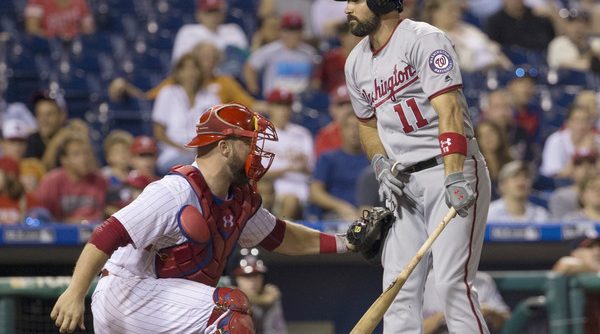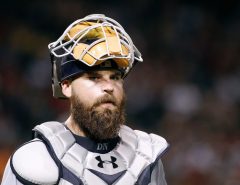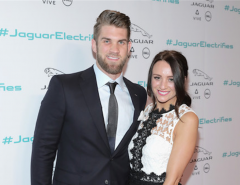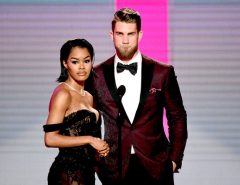The Nationals have a problem, they have a black hole at first base. I mean that figuratively of course; the Nationals have gotten the least offensive production out of first base in all of baseball. There may be a hole in the space time continuum at first, though, because Ryan Zimmerman has gone missing this season. Zimmerman’s .213/.269/.365 batting is far from acceptable from a first baseman. In fact, it makes him the worst offensive first baseman in all of baseball. He might as well have been pulled into The Upside Down.
With Zimmerman’s long track record in DC, it’s understandable that fans are looking for any sign of hope in Ryan. What people keep coming back to is Zimmerman’s batted ball exit velocity. Thanks to the wonders of Statcast, we now know that Ryan Zimmerman has the 13th highest exit velocity in all of baseball! Surely, this means he has been getting unlucky and it’s only a matter of time before those hard hit balls fall in for hits, right? Right?
As Lee Corso would say, not so fast. Average exit velocity is an interesting stat, but it’s a stat with no context. Hard hit balls come in all shapes and sizes. Breaking down Zimmerman’s numbers starts to show where the disconnect between Zimmerman’s production and exit velocity begins. So called launch angle, the angle the ball comes off the bat, is just as important as how hard the ball is hit. Hit a ball with a negative launch angle and it’s a groundball. Hit it with too high a launch angle and it’s a measly pop up. The ideal launch angle is around 12 degrees. Hard hit balls at something close to that angle will result in scorching line drives or possibly home runs. On the surface, Zimmerman’s average launch angle appears good. He’s averaged just over a 10 degree launch angle this year. It’s a little below ideal, but still in a line drive range. Dig down just a little more and Zimmerman’s results start to make more sense. Nearly half of his balls in play have come at ten degrees or below, meaning they are ground balls. Almost 10% of the remaining batted balls have been popups, batted ball types that turn into outs nearly 100% of the time.
On top of that, Statcast isn’t perfect and actually fails to record exit velocity and launch angle on a fair number of batted balls. Those balls are usually missed because they hit directly down, ground balls, or directly up, pop ups, results that aren’t good for the hitter. Assume that the balls that aren’t classified for Zimmerman are groundballs or pop ups, and a full 63% of balls that Zimmerman has put in play have been groundballs or pop ups. Hit the ball as hard as you want, but when 2/3 of your batted balls are groundballs or pop ups it is very difficult to have success at the plate. For comparison purposes, less than 50% of Daniel Murphy’s batted balls have would fall into the pop up, groundball, unclassified category. That right there is the biggest differentiator between the season Murphy is having and the season Zimmerman is struggling through.
So Zimmerman is in fact hitting the ball hard but more often than not he’s merely beating the ball into the ground. Whether Zimm’s struggles to get loft on the ball are due to his injured foot or a result of age taking its toll is meaningless for purposes of this season. Zimmerman won’t be able to turn it around on a dime in time for the playoffs and the Nationals need production out of the first base position. It seems obvious to say that Zimmerman isn’t cutting it, but what options do the Nationals have?
The easiest solution is to bench Zimmerman in favor of Clint Robinson. As a starter, Robinson is hitting only .250 with a .316 OBP, a line nearly 20% below average, but a line actually noticeably better than Zimmerman’s production. Robinson has been hurt by a low BABIP of only .255, but for a lumbering, pull-happy hitter like Robinson it’s hard to say whether that BABIP is low due to bad luck or if it’s a result of the defensive shifts Robinson has to face. Robinson also hasn’t been noticeably better facing right handed pitchers, so the idea of platooning Zimmerman against left handed pitchers and Robinson against right handed pitchers doesn’t do a whole lot for the Nationals. Robinson may be a slight improvement at the plate over Robinson but Zimmerman is clearly the better defender. Robinson may not be the answer.
The other option is to shift Murphy over to first base, slide Trea Turner back to the infield at second base and put Ben Revere back in center field. It would certainly upgrade the first base position to move Murphy there but it would mean consistent at bats for Revere who has been one of the worst offensive players in all of baseball in 2016. His defense in center field has been average or below average, so Revere doesn’t make up for that terrible offensive production with defensive value. If the Nationals want to get weird, they could consider getting Stephen Drew consistent playing time at second base, letting Murphy shift over to first and leaving Turner in center. While Drew has been fine as a bench bat, he’s exactly that: a bench bat. He’s got some pop but he won’t be much of an upgrade over Zimmerman either.
Unfortunately for the Nationals, they find themselves heading into the playoffs without a capable option at first base. Zimmerman hasn’t been good, he doesn’t figure to rebound, and the bench doesn’t have a clear upgrade over what Zimmerman has (hasn’t) brought to the table. Failing to get a capable bat at first may end up being Mike Rizzo’s biggest failure this season. Of course, if Turner keeps hitting everything in sight, the Nationals may be able to win with you or me at first base.
Tags: Nationals, Nats, Ryan Zimmerman, Washington Nationals




Leave a Reply